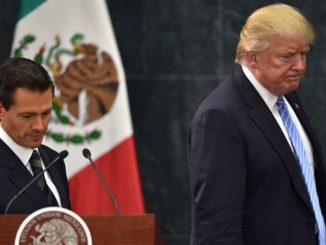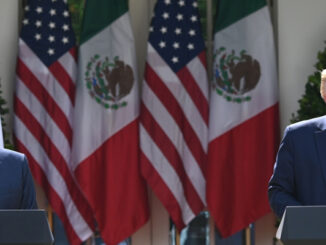
Growing economic integration with Mexico and Latin America could help the United States avoid the fate of an aging China.
By Howard W. French
Every now and then, a narrowly framed news item offers up glimmers of pathways toward the possible resolution of much bigger problems. And so it was this week, with a New York Times story, briefly promoted with the red font label of “breaking news,” that heralded Mexico beating out China for the first time in two decades as the leading source of U.S. imports.
The long-term significance of this trade data may not be altogether obvious. And just how big a deal it could become will ultimately depend on concerted, long-term geopolitical strategy.
But Mexico’s fast-growing role as the chief U.S. trade partner could provide a treasure trove of solutions to some of the most difficult challenges facing the United States. These include successfully managing peaceful competition with China, defusing the political crisis surrounding immigration, and renewing America’s credentials as a positive-sum actor in the 21st century.
For a country that proclaimed virtual dominion over its hemisphere through the Monroe Doctrine, which dates to the first half of the 19th century, the United States has long been curiously indifferent to the economic well-being of the American world to its south. Putting the 1994 North American Free Trade Agreement aside, one must go back to the Kennedy administration and its Cold War-driven Alliance for Progress to find a policy of engagement with Latin America with any real economic or political heft.
U.S. rivals have been far more strategic in linking their economic futures to neighboring regions. After experimenting with new models of globalization in Africa, in which it built infrastructure on a large scale, beginning in the 1990s, China followed up early in the last decade with its Belt and Road Initiative (BRI). Many Western commentators were alarmed and befuddled by China’s grand entry into an Africa that they had long taken for granted, but the BRI was a far more ambitious scheme.
It aimed to lash Central Asia and much of Western Europe together with China via the construction of enormous railway, road, port, and telecommunications projects as a way of integrating China ever more deeply into the global economy—but also tying all of these now more highly connected countries together with China itself. In Chinese, China’s name means “central kingdom,” and that’s a pretty good summary of the BRI’s ambition: to make China more and more central to the rest of the world.
The BRI has lost a bit of steam lately as China’s economy has begun to decelerate. But Beijing’s slackening emphasis on infrastructure projects overseas did not occur before its attentions had reached the distant shores of Latin America, the putative backyard of the United States. By virtue of its economic structure and strategy, China has racked up year after year of bulging trade surpluses with the much of the world.
It has to do something with these surpluses, and investment in Africa, the BRI, and its advances in Latin America form a major part of its strategy. Rather than merely parking fast-expanding trillions of dollars in wealth from trade in U.S. Treasurys, China has sought to make money from global infrastructure development as well. When this works well, it pays off in ways that go well beyond the balance sheet.
Much as Washington did after World War II, Beijing’s global building spree and lending programs have arguably turned it into the largest provider of so-called public goods. The United States often huffs and puffs about being the indispensable nation, but it has been a long time since that claim could be made in economic terms; for decades now, Washington’s main business has been as a broker and guarantee for some form of security. More and more, with most Americans seemingly scarcely aware of this, in economic matters large swaths of the globe think of their ties with China as being primary.
How does this all relate to the new Mexican trade data? In rational and objective demographic and economic terms, the ongoing American panic about immigration is groundless. The United States is in no way in danger of becoming an overcrowded nation. It has been enjoying some of the best employment data for half a century, meaning that immigrants are not taking jobs away from citizens. To the contrary, they are playing vital roles in an economy that would be hard-pressed to sustain recent fast rates of growth without them. This means jobs on farms, jobs in factories, and jobs in service industries of all kinds, from food preparation to health care and caregiving.
A continued renewal of the U.S. population through immigration is equally vital to the fiscal health of the country. As in most wealthy countries, fertility rates are suffering a sustained decline in the United States. The immigrant population trends young, and these young people are desperate for work. As they gain employment, they pay taxes, which is what finances the retirements of the many millions of American baby boomers who are cycling out of the full-time workforce.
Thinking of the United States and Latin America as totally separate spheres in which the movements of people from south to north can be effectively stoppered is a self-harming delusion. We live in not only a contiguous geography but a contiguous reality, and whatever this and any future administration might attempt to do at the southern border, people from Latin America will continue to make their way to the United States, where many of them already have established relatives, in large numbers.
Moreover, many studies have shown that encouraging, or at least tolerating, substantial migratory flows is the most effective known way of reducing global poverty and inequality. It is, in other words, a kind of public good and a way for the United States to continue to lead as a nation—doing well by doing good.
Finally, as Americans age, the U.S. economy will eventually scream for more immigrants and see contiguous Latin America as a big competitive advantage over even more rapidly aging China and Western Europe. Europe has become swept up in currents of anti-immigration sentiment that are more powerful even than those that exist in the United States. Much of this seems based on that continent’s parochial and anachronistic views of race and civilization, which drive fear of Black immigration from Africa and Muslim immigration from several neighboring regions. China is a long-term net exporter of people and has little experience with or prospect of large-scale immigration.
It may be hard to imagine today, but public opinion in the United States is likely to eventually come around to this reality, too. Why not be proactive now and get ahead of the curve?
The way to do that is through a major economic initiative linking the United States and Latin America. This needn’t involve the very same mechanisms that China employed with the BRI, but it should match Beijing’s recent ambition. Washington needs to come up with big new ways of engaging with the world to its south in economic terms in order to help boost prosperity in Latin America and turn the economies of Central and South America into places of much greater hope. This has to be innovative and persistent and must mobilize capital investments and encourage the spread of manufacturing and innovation among America’s neighbors.
There will be no overnight miracles. This can only work in a timespan measured in decades. Therein lies the best chance of moderating––not stopping––migration flows from south to north. The transformation of the economies to America’s south also means the transformation of their workers, through the development of much better education, much higher skills, and the kinds of high value-added activities that boost income levels. And as all of these things happen, something too will begin to happen with the immigrants who continue to flow from these countries. They will arrive with the ability to contribute more and more dramatically to the United States’ own economic growth and prosperity.
There is one further bonus here—a bank shot of sorts. Just as Mexico has been doing, an economically revitalized Latin America can make it far easier for the United States to de-risk its economic ties with China. This is not an argument for isolation or disengagement but rather a gradual and incremental diversification of the United States’ economic relations away from its biggest commercial rival.
Some possible objections come to mind. First among them is that it’s unrealistic. Those who wonder this, though, should ask themselves if the neglect and inertia that have characterized U.S. economic relations with much of Latin America in recent generations are realistic or remotely good for the parties concerned. The view here is no.
.



